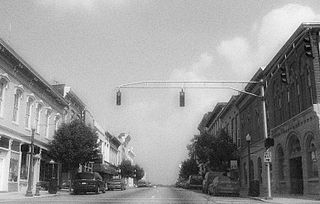
Shelbyville is a home rule-class city in and the county seat of Shelby County, Kentucky, United States. The population was 17,282 at the 2020 census.

The Most Worshipful Grand Lodge of Ancient Free and Accepted Masons of the Commonwealth of Massachusetts, commonly referred to as the Grand Lodge of Massachusetts and abbreviated GLMA, is the main governing body of Freemasonry within Massachusetts, and maintains Lodges in other jurisdictions overseas, namely Panama, Chile, the People's Republic of China, and Guantanamo Bay Naval Base, Cuba.
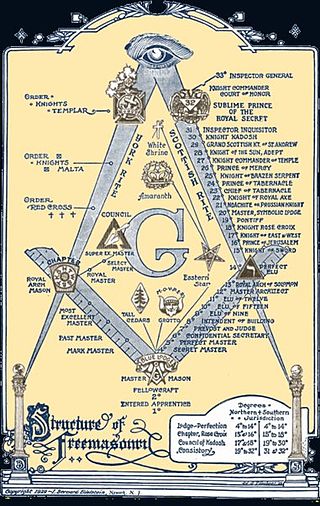
There are many organisations and orders which form part of the widespread fraternity of Freemasonry, each having its own structure and terminology. Collectively these may be referred to as Masonic bodies, Masonic orders, Concordant bodies or appendant bodies of Freemasonry.
Born in New Hampton, New Hampshire, on February 19, 1792, Simon Wiggin Robinson was the son of Captain Noah Robinson, who served honorably in the American Revolution. Young Robinson served his country, also, in the War of 1812 when he was stationed at Portsmouth, New Hampshire, as an Adjutant.
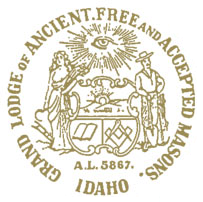
The Grand Lodge of Idaho is one of several bodies that govern Freemasonry in the U.S. state of Idaho as recognized by the United Grand Lodge of England. It was established in 1867 by five Masonic Lodges operating in Idaho Territory.
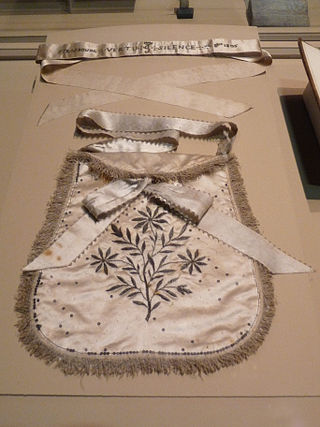
Freemasonry has had a complex relationship with women for centuries. A few women were involved in Freemasonry before the 18th century, despite de jure prohibitions in the Premier Grand Lodge of England.

This is a chronology of the formation of "regular" or "mainstream" Masonic Grand Lodges in North America, descending from the Premier Grand Lodge of England or its rival, the Antient Grand Lodge of England. A Grand Lodge is the governing body that supervises "Craft" Freemasonry in a particular jurisdiction or geographical area.
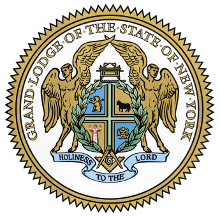
The Grand Lodge of New York is the largest and oldest independent organization of Freemasons in the U.S. state of New York. The headquarters of the Grand Lodge is the Grand Lodge Building located at 23rd Street in Manhattan.
The Most Worshipful Grand Lodge of Free and Accepted Masons of the State of Alabama, commonly called the Grand Lodge of Alabama, is one of two Masonic grand lodges in the state of Alabama, the other being the predominantly African American Prince Hall Grand Lodge of Alabama.
A Research lodge is a particular type of Masonic lodge which is devoted to Masonic research. It is a lodge, and as such has a charter from some Grand Lodge. However, it does not confer degrees, and restricts membership to Master Masons of some jurisdiction in amity with the jurisdiction that the research lodge is in. Related to research lodges are Masonic research societies, which serve the same purpose but function fundamentally differently. There are research lodges in most countries where Freemasonry exists.

The Masonic Widows and Orphans Home, located in Louisville near St. Matthews, Kentucky, is a historic building on the National Register of Historic Places. It was built by the Grand Lodge of Kentucky to support the widows and orphans of Master Masons, but now is open to all senior citizens.

The Grand Lodge of Free & Accepted Masons of Indiana is one of two statewide organizations that oversee Masonic lodges in the state of Indiana. It was established on January 13, 1818. The Grand Lodge of Indiana's offices and archives are located in the Indianapolis Masonic Temple. The historically black Most Worshipful Prince Hall Grand Lodge of Indiana F&AM is the second regular Masonic grand lodge in the state, and it was originally established in 1856 as the Independent Union Grand Lodge of Free and Accepted Masons of the State of Indiana. The two grand lodges agreed to mutual recognition in May 1998, and they jointly share sovereignty over the Masonic fraternity in Indiana.
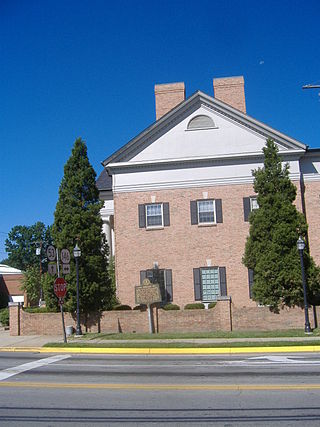
The Masonic University was an educational facility operated by the Grand Lodge of Kentucky in La Grange, Kentucky, located twenty miles northeast of Louisville, in the mid-nineteenth century. Among its faculty was Kentucky Chief Jurist and Confederate spy Thomas Hines, and Robert Morris, the poet laureate of Freemasonry.

Abraham Jonas (born September 12, 1801, in Exeter, England; died June 8, 1864) was the first permanent Jewish resident in Quincy, Illinois. He was a member of the Illinois and Kentucky state legislatures, a leading lawyer, Freemason, and a valued friend of Abraham Lincoln.

The Grand Lodge of Ohio, formally known as the Grand Lodge of Free & Accepted Masons of Ohio, is the governing body of the largest group of Masonic lodges in Ohio. The Grand Lodge of Ohio follows the Anglo-American tradition of Freemasonry that is common in the United States. In 2023, the Grand Lodge reported a total membership of 75,000 Master Masons.
The Keene Springs Hotel is a rambling wood-frame, two-story Greek Revival-style building built in sections in 1841 by Mason Singleton Jr. in the hamlet of Keene, near Nicholasville, Kentucky in Jessamine County. He and his wife Nancy owned and operated the hotel and tavern as a resort destination for the white sulphur springs nearby. During the cholera epidemic of 1848–1849 and outbreaks in the early 1850s, residents of Lexington came to the hotel to try to escape the spread of disease in the city. The Singletons operated the hotel until 1857, when they sold it to Alfred McTyre.
The following is a timeline of the history of Lexington, Kentucky, United States.
The Most Worshipful National Grand Lodge Free & Accepted Ancient York Masons Prince Hall Origin National Compact USA is a body of Masonry in the United States of America composed predominantly of African American Freemasons. It governs Grand Lodges within the United States.
The Supreme Council, Scottish Rite, Northern Jurisdiction oversees the Scottish Rite of Freemasonry in fifteen states: Connecticut, Delaware, Illinois, Indiana, Maine, Massachusetts, Michigan, New Jersey, New Hampshire, New York, Ohio, Pennsylvania, Rhode Island, Wisconsin and Vermont. This territory has existed since 1827 when the NMJ gained jurisdiction "over the then 14 states situated east of the Mississippi and north of the Mason-Dixon Line. Wisconsin was not yet a state, but part of Michigan."
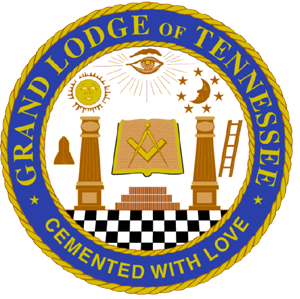
The Grand Lodge of Tennessee, officially the Grand Lodge of the Ancient and Honorable Fraternity of Free and Accepted Masons of the State of Tennessee, is the main governing body of Freemasonry within Tennessee. This Grand Lodge was established in Knoxville, Tennessee, on December 27, 1813, by nine Masonic lodges operating within the state. In 2017, the Grand Lodge of Tennessee had a reported membership of 34,858 Master Masons, and by 2020 the membership had fallen only slightly to 33,200.

















